
The wait of justice 2020: possession enforcement times before and after covid
Key findings
- Possession action was dropping prior to Covid, likely as a result of less rent arrears. The number of possession claims in Q1 2020 suggest that prior to Covid, this year was set to have the lowest number of private landlord possession claims since at least 1999.
- The reported drop in possession action did not result in possession orders being issued more promptly, suggesting that courts were operating at capacity and would not be likely to improve further without increasing resources.
- Despite fewer possession orders being issued, a higher proportion of landlords have had to use bailiffs to enforce judgements.
- Bailiff wait times vary substantially across the country with London and the East Midlands performing particularly poorly.
- HMCTS is struggling to recruit sufficient bailiffs.
Key recommendations
- To ensure that possession action remains at the low levels in Q1 2020, the Government should consider offering further financial support to weather the impact of Covid on tenant finances. Low or no-interest loans to tenants like the Welsh Tenant Savers Loans should be considered.
- To ensure the courts are not overstretched while clearing the backlog of cases built up during the stay on possessions, additional capacity should be introduced to the court system. One option for this would be to expand the number of 'nightingale courts' available.
- To improve bailiff retention and standardise wait times across the country, additional funding should be allocated to increase the attractiveness of the position and the total amount of bailiffs available.
Introduction
There are few areas of our lives which the Coronavirus pandemic has not affected in some way and the private rented sector is no exception to this. Landlords have had to cope with a number of substantial issues throughout much of 2020 ranging across all of the work that landlords do as part of their everyday business.
Whether it was arranging a viewing, organising a gas safety inspection, or managing an HMO, to prevent the spread of the virus landlords had to make sweeping changes to the way they would normally operate, often at increasing cost to themselves.
This was all done against a backdrop of increasing rent arrears, with over half of all landlords reporting a drop in rental income as their tenants grappled with increasing job insecurity and in many cases being furloughed.
Possession during Covid
Despite these pressures, relatively few landlords have sought possession during the pandemic. However, for those that did, or those already seeking possession prior to the pandemic, they faced substantial difficulties and constant changes to the rules around possession.
Starting with the suspension of all possession proceedings from March 27 2020, landlords have had to deal with changing notice periods, last minute delays to the courts reopening, complex and confusing new rules about applying to court once they did reopen, and a new priority system that put the most common form of notice (Section 21) at the back of the queue.
This confusing situation continues to evolve. At the time of writing, the courts had reopened, meaning possession orders can be granted. However, the Government has legislated to prevent bailiffs from enforcing them in England until 11 Jan 2021 at the earliest.
For those landlords who had applied to court prior to the pandemic, this means they will usually be waiting at least a year to regain possession from a tenant who is in arrears. Even those who began possession action during the pandemic will also be dealing with substantial delays and backlogs while the court works its way through the backlog of cases that built up during the pandemic.
Researching possession wait times prior to Covid
With all this in mind, the NRLA decided to investigate how the courts were working prior to the pandemic to give some insight into how they are likely to cope once the possession system reopens in full. This follows on from previous work on wait times in London and at the national level published earlier in the year.
Through a series of freedom of information requests, we collected information on court and bailiff wait times across each region of England. We also collected information on bailiff recruitment. Through this we have identified a number of areas that were concerning prior to lockdown. These issues are likely to be exacerbated by backlog of cases the courts will have to deal with through 2021.
How often were the courts being used prior to lockdown?
The vast majority of landlords do not seek to end tenancies and regain possession of their properties. Around 4.5 million households live in the private rented sector (PRS). In 2019, 43 thousand tenancies were ended by a possession order granted to a private landlord or granted via accelerated possession. Not all accelerated claims will relate to private landlords (a significant proportion may relate to registered social landlords) but it does set an upper limit on how many claims may relate to a private landlord. As a result, at most, slightly less than 1% of tenancies are ended each year in court by a private landlord.
Where possession is sought, our previous research found that regardless of the notice used, it will usually be served because of rent arrears. When surveyed, 97% of Section 8 and 83% of Section 21 users reported arrears as a reason for service.
Happily, since our last investigation into court wait times, there was a significant drop in the number of private landlords seeking possession orders in England. Based on our previous research this would suggest that fewer tenants were falling into arrears of rent at the beginning of 2020.
Chart 1: Private landlord possession orders per quarter Q1 2019-Q2 2020
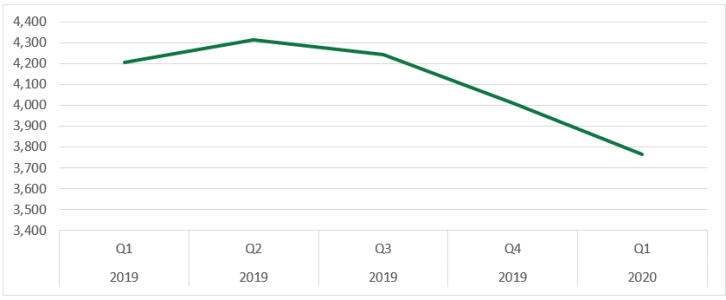
Private landlord possession orders dropped from a peak of 4,313 claims per quarter in Q2 2019 to 3,764 cases in Q1 2020. This drop has largely been driven by a large decline in the number of possession claims in London. However, the majority of regions in England saw some decline when compared to Q1 2019.
Chart 2: Total private landlords possession orders by region Q1 2019 v Q1 2020
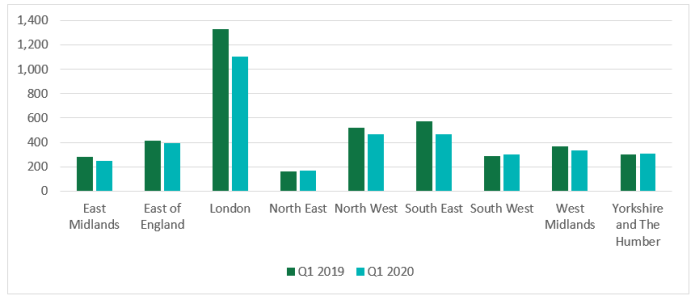
There was an even more substantial drop in the number of accelerated claims; from 4,039 claims in Q1 2019 to 3,137 claims in Q1 2020.
Chart 3: Total accelerated possession orders Q1 2019 – Q1 2020
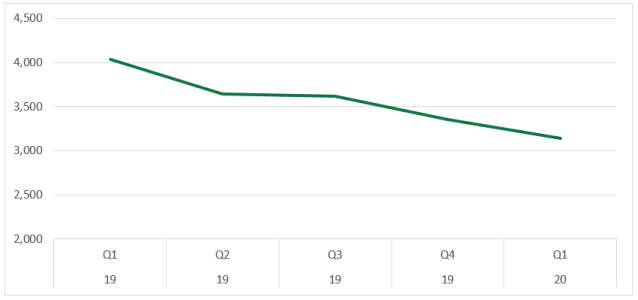
Overall, it appears that prior to the pandemic, this was set to be the lowest year for possessions since the earliest available figures in 1999. Had Q1’s figures been replicated throughout the rest of the year, around 27,000 possession orders would have been granted; equivalent to 0.6% of households in the PRS.
Will this reduction in possession claims continue?
Given that most possession claims are brought because of rent arrears, this will depend on how much of an impact the pandemic has on landlord finances. Unfortunately, the economic impact of Covid has been felt by many. With unemployment rising, more tenants will be moving on to Universal Credit; a system that is strongly associated with increased rent arrears. This means that it is likely that possession cases will have increased in comparison to the start of the year.
The number of possession cases is likely to be lower than some tenant groups have claimed though; largely as a result of landlords’ active forbearance. NRLA research found that landlords have, for the most part, provided financial support to tenants struggling with furlough or unemployment as a result of Covid, even though 54% of landlords have reported a loss in income over this period.
Maintaining a low level of possession claims
Expecting landlords to continue to financially support tenants is unlikely to be a long-term solution. Over 80% of landlords own between one and four properties so they are not well insulated against sustained financial shocks to their business model. Without direct financial support to ensure continuous rent payments, landlords will at some point have to start taking possession action.
Unfortunately, so far there has been little evidence of this direct support materialising in England, with financial support limited to mortgage holidays for landlords. Instead, the Government has focused on providing support to tenants via furlough as well as increasing the housing component of Universal Credit. However, given 54% of landlords are reporting a drop in income it would seem this is not sufficient to ensure rent is paid on time or in full. Long term, this is likely to lead the tenants into unsustainable debts, reduce the number of homes available as landlords leave the sector, and increase the strain on the courts as they try to clear the backlog from the suspension of possession activities.
The outlook is brighter in Wales, where the Senedd has introduced low-interest Tenancy Saver Loans as a result of NRLA lobbying. These loans are aimed at providing tenants with easily repayable loans that will be paid directly to the landlord to ensure the rent is paid and the tenant remains secure in their property. We would recommend that the Government looks to introduce this option in England too. Ideally ahead of bailiffs being able to enforce possession orders again.
How quickly were the courts processing possession orders?
While the number of cases the court handled had decreased, it does not seem to have made any appreciable difference to the national average for processing claims.
Chart 4: Average time taken from making a claim to receiving a possession order (private landlord claims)
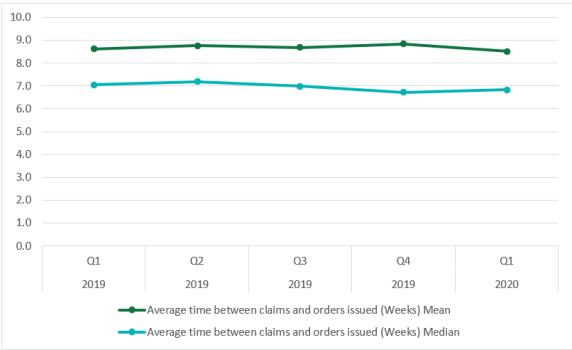
While broadly speaking most regions fit into these averages there is some regional variance. London and the West Midlands stand out as particularly slow for issuing possession orders. The average landlord in these areas waited over 10 weeks for a possession order hearing.
For accelerated possession claims there has been little movement at a national level. Accelerated claims took 6.9 weeks on average to result in a possession order in Q1 2020 compared to 7.1 weeks in Q1 2019. Though landlords in London and the South East of England experienced longer than average waits prior to lockdown.
This relatively static average indicates that the court system was operating at capacity prior to lockdown. Some areas of the country could still improve but 4-6 week waits for accelerated claims and a 7-9 week wait for possession hearings are likely to be the benchmark without further funding to bring it down to the ideal time frames.
How is the pandemic likely to impact on these averages?
It will be almost impossible for possession cases to be heard at the same pace now that the courts have re-opened and it may take some time before the average case is heard this quickly again.
The courts may have re-opened but they are operating in a limited capacity under social distancing rules. They are also working through the backlog of cases from prior to lockdown, as well as any cases that started in Q2 and Q3 of 2020.
Prior to lockdown, the fastest and most efficient way for landlords to regain possession was to serve a Section 21 notice and gain access to the paper-based accelerated possession process. This is not the case under the new rules for allocating hearings and landlords who have used Section 21 are likely to face substantial waits.
Under the new rules, accelerated possession claims are not scheduled. Instead, they are dealt with during the time scheduled for cancelled hearings or in the spare time available to a judge. Other possession hearings can be scheduled, typically following Section 8 notices, but they are done so on the basis of a priority system. Under this new system, Section 8 notices with anti-social behaviour or extreme rent arrears of 9 months or more given priority over others.
Rules around the timing for scheduling hearings have also been temporarily removed, allowing the courts to schedule cases far into the future if they deem it necessary.
Overall, these changes mean landlords should prepare for a long wait to receive a possession order, particularly in the areas that were already facing longer than average delays. One potential option to prevent this would be to expand the number of additional 'nightingale courts' to cope with the likely backlog. Increasing capacity would allow for faster processing, even with the requirements around social distancing.
The bailiff bottleneck
Applications for possession orders dropped significantly between Q1 2019 and Q1 2020. No similar drop exists for the use of bailiffs, however. In Q1 2019, there were 1,777 warrants of possession enforced in England. In Q1 2020, this had dropped slightly to 1,708 warrants enforced.
While fewer landlords were seeking possession, a higher proportion of tenants were refusing to leave the property once a possession order was issued. This raises the question of why these tenants persisted in remaining in the property after a possession order is issued?
The Homelessness Reduction Act places a duty on local authorities to provide support to tenants presenting as homeless prior to possession being granted. If these tenants are not receiving this support then it indicates that either:
- local authorities do not have the resources to meet their duties; or
- these tenants are classed as intentionally homeless due to the build up of rent arrears.
In either event, just under half of landlords who go to court are likely to need a bailiff, and they are likely to want one who arrives promptly.
Unfortunately, the average landlord seeking possession experiences a long delay in enforcing a possession order once the courts are satisfied they are entitled to possession. Both the median and mean average for enforcement increased from Q1 2019 to Q1 2020. This bailiff bottleneck effectively doubles the wait for repossession in most areas of the country.
Chart 5: Average time taken between starting a claim for possession and regaining possession
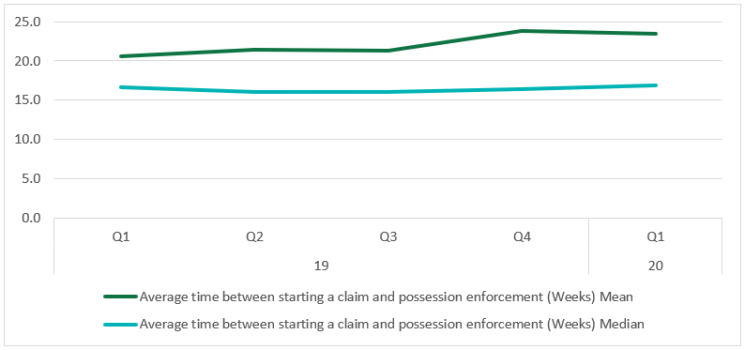
The enforcement postcode lottery
At a regional level, we can see that average enforcement times varied significantly. Some areas waited over six months on average to enforce a possession order. The East Midlands is the worst performer on the mean average for private landlord possession claims, but London remains stubbornly high as well, with a higher median time than any other area.
Chart 6: Regional averages for private landlords making a claim to regaining possession via bailiff enforcement (weeks)
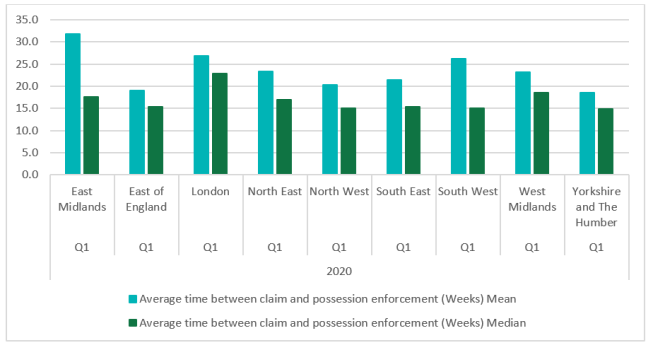
For accelerated possession, average waits also varied substantially. Though landlords in London can expect to wait significantly longer than anyone else for a bailiff. Average enforcement times increased to a staggering 34.7 weeks in the capital, increasing the time required to regain possession by nearly 300%.
Chart 7: Comparison of accelerated possession enforcement times by region Q1 2019 v Q1 2020
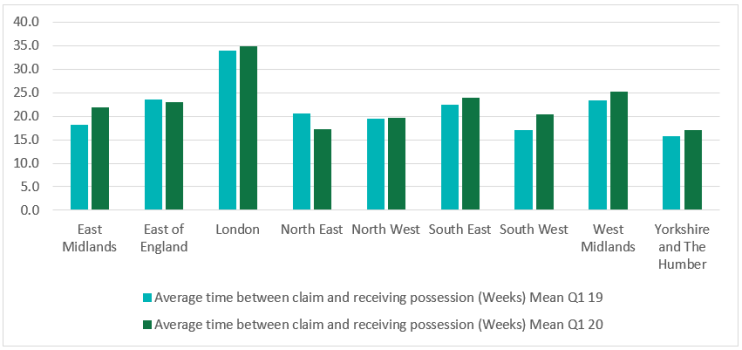
The high variance across regions suggests there are insufficient bailiffs to cover demand in specific regions or courts. Given the backlog that has built up during the pandemic, any staffing issues in these regions need to be addressed as soon as possible if court enforcement is to be effective once bailiffs resume their activities.
Are there enough bailiffs?
In 2019, the Residential Landlords Association made a freedom of information request to Her Majesty’s Courts and Tribunal Service (HMCTS).
This request sought to identify the number of bailiffs operating in England and Wales and whether there was a shortfall that could explain the long wait times that landlords face when seeking repossession.
As a result of this freedom of information request we know that:
- In the financial year 2019/20, HMCTS was funded for 308.3 full time equivalent bailiffs in England and 24.3 full time equivalent bailiffs in Wales.
- As of September 2019, the number of actual full time equivalent bailiffs in post was 271.6 in England and 20.3 in Wales.
- Bailiff recruitment and retention appears to be difficult. Of 72 positions advertised between Aug 17 and Aug 19, only 38 were filled.
While private landlord possession claims are relatively low, bailiffs remain relatively busy overall. With 367,813 warrants issued across England and Wales in 2019, each bailiff is responsible for 1259 warrants over the course of a year. Taking into account typical working hours and holidays, this means each bailiff is responsible for 5-6 warrants on any given working day, leaving no real room to increase their workload.
The salary for bailiffs is also not particularly attractive. Typically, advertisements for bailiff positions offer a salary of £19-21,500 per annum. This is equivalent to £364-412 per week; significantly below the UK median salary of £586 per week which may go some way to explaining the difficulties in recruiting and retaining additional bailiffs. Particularly as High Court Enforcement Officers (HCEOs) share the same required skills for a higher financial reward.
Recommendations for improving access to bailiffs
There appears to be scope to increase bailiff salaries to make the position more attractive and improve wait times. Similarly, there is also scope to increase the total number of bailiffs in to address demand, particularly in areas already experiencing long wait times.
Based on the advertised salaries, the estimated budget for bailiff salaries in the UK is between £6.3 and 7.1 million. This is a relatively small proportion of the revenue brought in from applications for warrants.
In 2019, claimants spent £31.7 million making applications for warrants of control, possession, or delivery. This was smaller than in previous years but still substantially more than the salary allocated for bailiffs. More of this funding should be made available to increase bailiff capacity and ensure retention of staff.
If this is not possible, then we would recommend widening access to the more efficient High Court Enforcement Officers (HCEOs). This would allow landlords to sacrifice their legal costs to regain possession in a relatively timely fashion. Given the changes to prioritising cases and the extended notice periods, many landlords will have waited over a year to receive their possession order, often with no rent at all. This is a financially unsustainable position for landlords. They cannot be expected to wait for extended periods to enforce possession once the courts have confirmed they are entitled to regain possession. Particularly not in areas like London where landlords may wait six months or more for a bailiff to enforce possession for them.
In conclusion
Prior to the pandemic it appears that landlords, already unlikely to seek possession, were becoming even less litigious. Given the strong link between possession and arrears it would also suggest that more tenants than ever before were paying their rent on time and in full.
However, despite this increase in tenure stability and the resulting reduction in pressures on the court system, possession continued to be extremely slow in Q1 2020. This suggests that the courts are operating at capacity and will not be able to cope with the likely backlog created by the suspension of possession through much of 2020. Similarly, bailiffs appear to be overstretched and under-resourced judging from the significant wait times for enforcement of possession. Work needs to be done ahead of 11 January 2021 to ensure that the system can cope with this increased burden and clear the backlog, whether through increased staffing or more generous access to the high court's more efficient service. Otherwise many landlords will be waiting until far into 2021 to regain possession of properties.
At the same time, the best way of ensuring the courts are not overstretched is to ensure that rent is paid in full. As the number of possession cases in Q1 2020 indicate, landlords do not want to seek possession where rent is paid. Direct rent payments based on low/no interest loans to tenants would allow them to avoid unsustainable debt and continue to live in the property. This would reduce the number of possession claims, allowing the courts to focus on other cases where possession cannot, and should not be avoided, such as serious anti-social behaviour or criminal behaviour.

